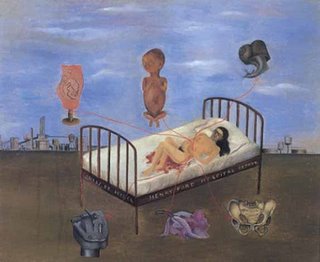Frida Kahlo at Bucerius Kunst Forum
 Frida Kahlo, Henry Ford Hospital, 1932. Oil on metal, 31 x 38,5 cm. Museo Dolores Olmedo Patiño, Xochimilco, Mexico.
Frida Kahlo, Henry Ford Hospital, 1932. Oil on metal, 31 x 38,5 cm. Museo Dolores Olmedo Patiño, Xochimilco, Mexico.Frida Kahlo at Bucerius Kunst Forum
HAMBURG, GERMANY.-The Mexican painter Frida Kahlo (1907–1954) is the focus of this year’s summer exhibition at the Bucerius Kunst Forum, located on the Rathausmarkt in Hamburg. Through September 17, 34 paintings, drawings and watercolors by this famous artist, representing all her creative periods, will be displayed. Since not a single one of Frida Kahlo’s works is owned by a museum in Germany, this is the first opportunity in more than 10 years to view her art in the original. In 1939, an unknown Mexican painter appeared on the stage of the Paris art scene. Surrealists enthusiastically admitted her to their ranks, believing they had discovered a type of Surrealism that had developed entirely independently of their own. Kahlo allowed everyone to believe this, saying, “I had no idea that I was a surrealist painter.” It goes without saying that Frida Kahlo’s pictorial world cannot be understood without knowing something of her biography. Her serious accident, her complex relationship to her husband, the famous muralist Diego Rivera, her numerous affairs, her heartfelt attachment to Mexican traditions and her political involvement all left their marks on Frida Kahlo’s art. As a testament to her suffering and passion, her unconventional spirit and her rebellious sense of humor, her work allowed Frida Kahlo to become one of the most colorful personalities of the 20th century. Nevertheless, Kahlo’s life’s work is much more than the sum total of a fascinating life. Frida Kahlo’s fantastically heightened realism, her unsettling combination of motifs and her collage techniques are closely related to the international artistic developments of her time, which include Dadaism, Neue Sachlichkeit (New Objectivity), Pittura Metafisica (Metaphysical Painting) and Surrealism. Frida Kahlo was well acquainted with these artistic movements: During the years she spent in the USA (1930–1933), she had contact to important artists, museum directors and gallery owners; she visited landmark exhibitions and owned important art catalogs. The exhibition at the Bucerius Kunst Forum shows to what extent Kahlo’s interest in European avant-garde art inspired her own painting. Around 20 works – including paintings by Max Beckmann, Giorgio de Chirico, Otto Dix, Max Ernst, George Grosz, René Magritte, Meret Oppenheim and Christian Schad – demonstrate for the first time the international context in which Frida Kahlo painted, thereby opening new insights into this Mexican artist’s work. Today, Kahlo’s art is a part of Mexico’s National Heritage and in accordance with the wishes of her husband, Diego Rivera, her paintings may never leave the Frida Kahlo Museum in Mexico. With the famous Dolores Olmedo Patiño collection, the Bucerius Kunst Forum has brought the largest private collection of Frida Kahlo’s works back to Germany for the first time since 1993 in the year before Kahlo’s 100th birthday.
(from artdaily.com)

0 Comments:
Post a Comment
<< Home